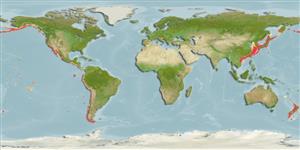Polychaeta |
Sabellida |
Serpulidae
Environment: milieu / climate zone / গভীরতার পরিসীমা / distribution range
বাস্তুসংস্থান
. Temperate
Pacific Ocean, Northeast Atlantic and the Mediterranean Sea: Japan, Kamchatka Peninsula, England, Mexico, Peru and Galapagos Islands.
Length at first maturity / আকৃতি / Weight / Age
পরিপক্কতা : Lm ? range ? - ? cm
Infralittoral rock and other hard substrata (Ref. 1314).
Life cycle and mating behavior
পরিপক্কতা | প্রজনন | ডিম ছাড়া | Eggs | ডিম্বধারন ক্ষমতা | Larvae
Members of the class Polychaeta are mostly gonochoric (sexual). Mating: Females produce a pheromone attracting and signalling the males to shed sperm which in turn stimulates females to shed eggs, this behavior is known as swarming. Gametes are spawned through the metanephridia or body wall rupturing (termed as "epitoky", wherein a pelagic, reproductive individual, "epitoke", is formed from a benthic, nonreproductive individual, "atoke"). After fertilization, most eggs become planktonic; although some are retained in the worm tubes or burrowed in jelly masses attached to the tubes (egg brooders). Life Cycle: Eggs develop into trocophore larva, which later metamorph into juvenile stage (body lengthened), and later develop into adults.
Hill, M., R. Baker, G. Broad, P.J. Chandler, G.H. Coop, J. Ellis, D. Jones, C. Hoyland, I. Laing, M. Longshaw, N. Moore, D. Parrott, D. Pearman, C. Preston, R.M. Smith and R. Waters 2005 Audit of Non-native Species in England. English Nature Research Reports Number 662. 82 p. (সূত্র 1314)
IUCN Red List Status
(সূত্র 130435: Version 2025-1)
CITES status (সূত্র 108899)
Not Evaluated
Not Evaluated
Threat to humans
Human uses
| FishSource |
হাতিয়ার
আরো তথ্য
ট্রফিক বাস্তুতন্ত্র Food items (preys)
পথ্য উপাদান
খাদ্য গ্রহণ
শিকারী প্রাণী সমূহ
Population dynamicsবৃদ্ধি
Max. ages / sizes
Length-weight rel.
Length-length rel.
Length-frequencies
Mass conversion
প্রাচুর্য
Life cycleপ্রজনন পরিপক্কতা ডিম্বধারন ক্ষমতা ডিম ছাড়া EggsEgg developmentLarvae Physiologyঅম্লজান ব্যবহার
Human RelatedStamps, coins, misc.
ইন্টারনেট সুত্র
Estimates based on models
Price category
Unknown.
